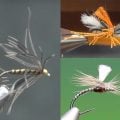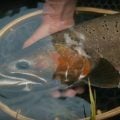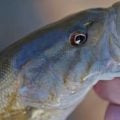Balancing Recreation and Conservation
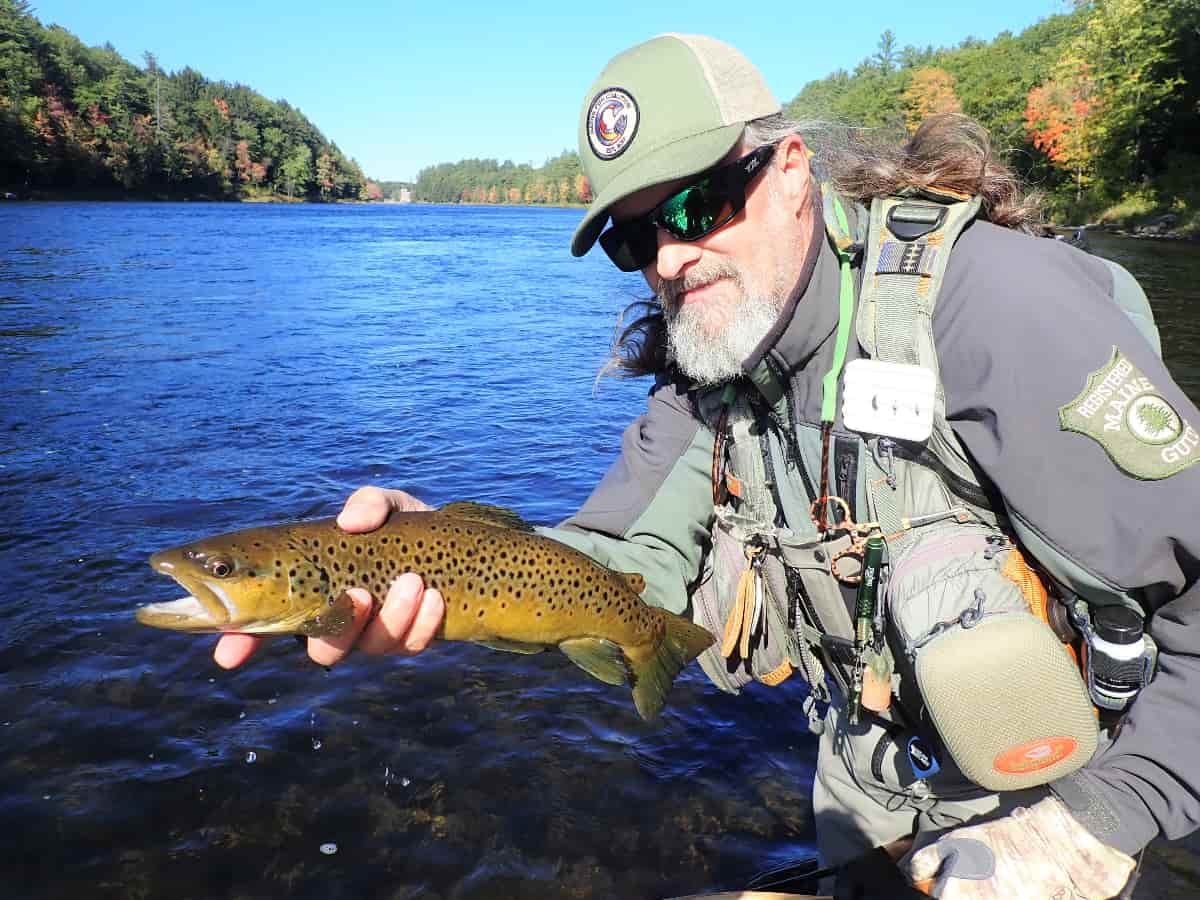
The author with a holdover nonnative brown trout in historic Atlantic salmon water. Image by Emily Bastian
I call my home water “Madison,” and have done so for over 20 years. It’s not the fabled southwestern Montana trout river, but a stretch of the Kennebec River in central Maine nestled between the towns of Madison and Anson. I call it Madison because I access it primarily from the Madison side of the river,
Madison is big water by any standard. One hundred yards wide with 3,500 cubic feet per second considered low flow. Flows over 5,000cfs are quite common, and flows over 10,000cfs not uncommon. This roughly 1.5 mile section of mixed riffle and rapids begins at a small top-flow dam and an odd outflow coming from underneath a large mill complex. It ends at a large pool just upstream of where a substantial tributary enters.
The spring-rich area around Madison was the site of a large Native American village. It was also the scene of a massacre where in August of 1724, roughly 80 Abenaki led by Chief Bomazeen (or Bomoseen) along with French Jesuit missionary Father Sebastian Rasle, sometimes referred to as Rasles or Rale, lost their lives fighting British militia concerned about growing French influence.
Today Madison is an oddly tranquil place, especially when you consider that it is just outside of town and less than a mile from a large mill complex. Bald eagles nest in the old growth white pines along the river, beavers patrol the river from lodges built into the bank, and I have seen deer and moose cross the river as well. I call it “the illusion of seclusion.”
After more than a year and a half away, I returned to my home water. The 2022 season had been cut short due to fall rains that bumped the river up beyond wadable levels for the rest of the fishable season. Nearly endless rain and chronic high water kept me off Madison for the entire 2023 season—the first time this has happened in over 20 years of fishing there.
As I neared the water on the trail in, I encountered piles of debris deposited by a late December 2023 flood that pushed the river well over 100,000 cubic feet per second. The debris was 20 feet above the current water level and covering the last 30 feet or so of trail. The boardwalk over the primary spring was raised and tilted.
While the shoreline had changed due to downed trees and accumulated debris, the river seemed oddly intact considering what had transpired. As I pushed out into what is basically a hundred-yard-wide riffle, the subtle but important fish-holding troughs etched into my mind over 20 years of fishing there were still there. So were the more notable rocks.
Mother Nature can be extremely violent, yet oddly resilient. Lesser waters than Madison can change notably from one year to the next. While many smaller rivers and streams in the area had changed significantly under the weight of what was an epic high water event, Madison was pretty much as I left it a year and a half earlier.
To be clear, Madison is everything a water shouldn’t be. It is stocked with nonnative brown trout and home to a self-sustaining population of nonnative smallmouth bass. While browns are the primary draw, there is some level of brook trout due to an ill-advised dump where they have virtually no chance of surviving. Wild landlocked salmon and rainbow trout, both nonnative, occasionally drop down from upriver.
By late June, the water at Madison warms up, the trout disappear, likely to the deep slow water downstream, and nonnative smallmouth bass move in en masse. Trout fishing is all but over until the water starts cooling in late August or early September depending on the year. Spring mayfly hatches usually occur when the river is too high to wade, and the once prolific fall BWOs have become horribly unreliable.
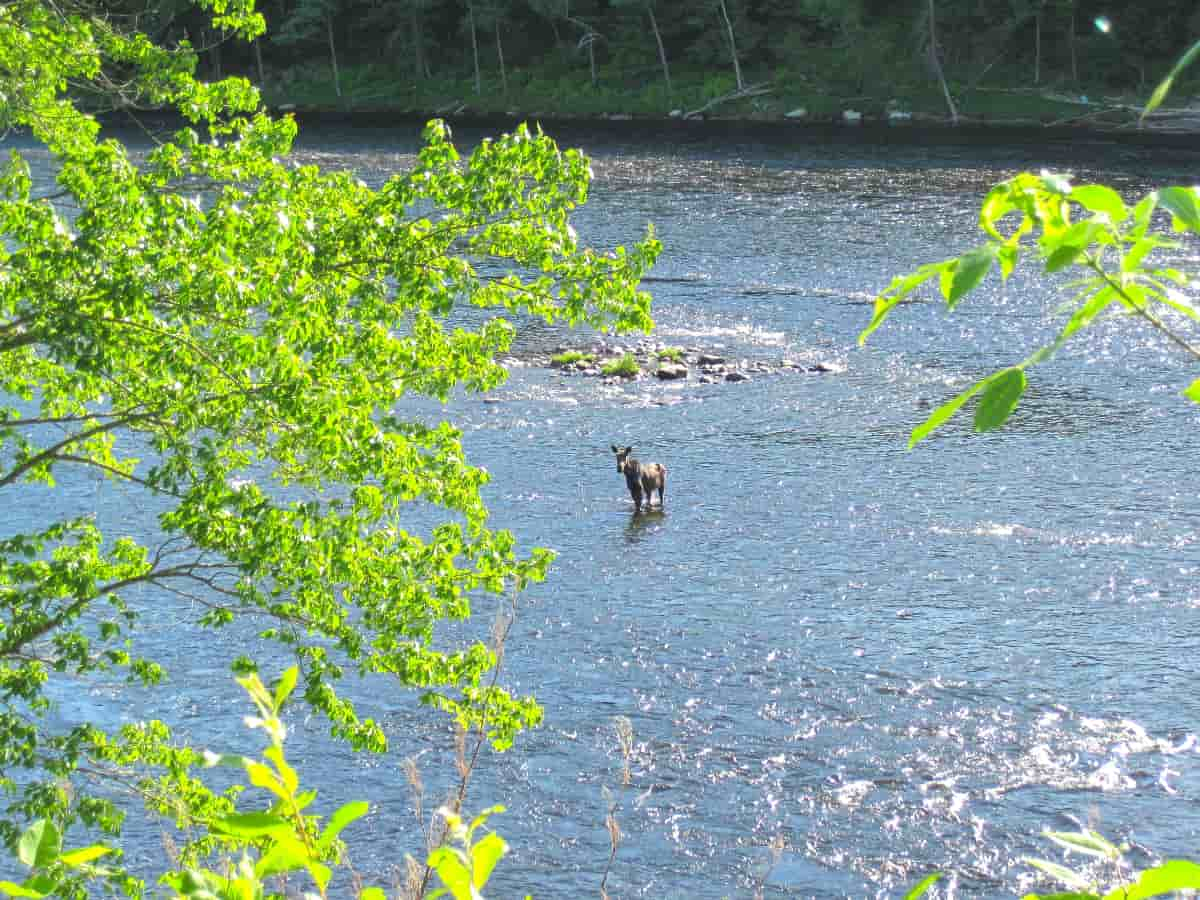
A young moose crossing the Madison section of Maine’s Kennebec River just a mile outside of town. Image by Bob Mallard
The banks of Madison are littered with broken glass and other debris, the result of a shoreside picnic area that was popular at a time when littering was an accepted and common practice. Several attempts to mobilize area folks to undertake a clean-up when I owned my fly shop just 7 miles away failed. I cringe whenever I see unsuspecting people bring their dog to the water due to the broken glass.
While the upper Kennebec River was once a wild native brook trout fishery of note, and still holds some impressive fish, Madison was most likely never a significant brook trout fishery. A sprawling warmwater river, it was more likely that Madison was historically primarily a native fallfish and sucker water with various minnows such as dace and chubs.
Madison was, however, once home to federally, and critically, endangered Atlantic salmon. The Sandy River, which denotes the downstream end of Madison, is said to hold as much as 50% of the Atlantic salmon spawning habitat in the system. While access to the Sandy River is blocked by several downstream dams, adult salmon are trucked 50 miles upstream for planting in the river.
There is a prominent rock outcropping roughly 7.5 miles upstream of Madison known locally as “Salmon Rips.” A late 1860s report attributed to Charles G. Atkins, Maine’s first Fisheries Commissioner, states that Atlantic salmon ascended Caratunk Falls, 12 miles upstream of Madison. This would mean that Atlantic salmon pushed notably further up the Kennebec River than Madison.
A decade or so ago in late November, I caught an unusually dark colored salmon over 20-inches long with a pronounced kype. The fish took a large streamer in very heavy water while I was searching for post-spawn brown trout. While landlocked salmon are present in the river, I am convinced that it was a sea-run fish. Why it was there is a mystery.
In the early 1800s, the Kennebec is said to have supported runs estimated to be in excess of 100,000 fish at times, making it one of the most significant Atlantic salmon rivers in the nation. With upwards of half the fish utilizing the Sandy River for spawning, and some level of fish pushing even further upriver, Madison once played an important role in Atlantic salmon in Maine.
I fish Madison because it is close to home. Although a native fish advocate, I do so without guilt as I did not introduce the nonnative bass, initiate nonnative brown trout stocking, or build the dams that are blocking Atlantic salmon from their historical spawning grounds. As far as the bass go, they are here to stay as they are now found throughout the entire Kennebec system.
At less than 30 minutes from my home, I enjoy fishing a spring evening caddis hatch, or fall midday Isonychia or BWO hatch at Madison. One of my favorite things to do is to drop into the river in the fall at what I call the Caddis Pool and fish my way down to what I call the Log Pool, casting a large streamer to every likely holding spot.
The world is not a perfect place, and at times it’s quite imperfect. While I am staunch wild native fish advocate, that doesn’t mean that I won’t fish for nonnative or even stocked fish. I don’t see it as a conflict of interest when they are there and there is nothing I can do about it. But I won’t advocate for stocking or the preservation of self-sustaining nonnative fish no matter how much I enjoy fishing for them.
Like my advocacy, my fishing is pragmatic. It is based on ecological realities not absolutisms. The idea that wild native fish advocacy is a threat to fly fishing is foreign to me. It is unnecessarily alarmist. Native fish advocacy is about putting the resource first where it is possible and practical to do so. In the case of Madison, I’ll enjoy what’s there while not losing sight of what is not there, wild native Atlantic salmon.
Although I enjoy fishing Madison, it can never replace the wild native brook trout water just an hour or so from my home. While it will be an uphill battle, I’d love to see Atlantic salmon return to Madison. If suspending brown trout stocking would help restore the salmon, I’d fully support it because it would be the right thing to do, even though it would mean the loss of my home water.








